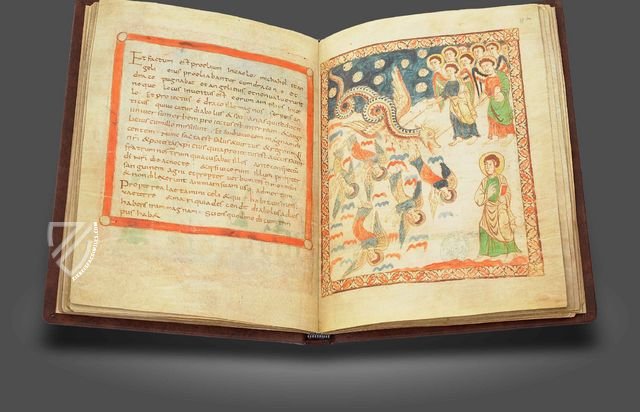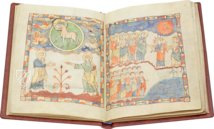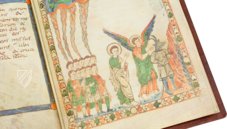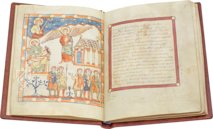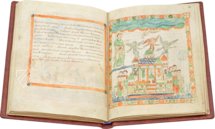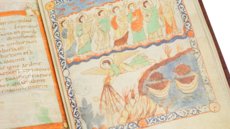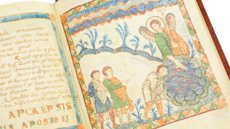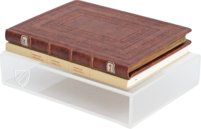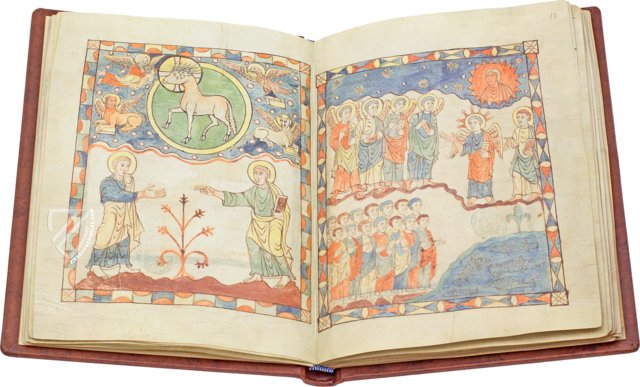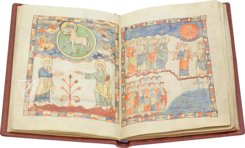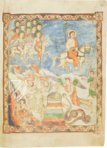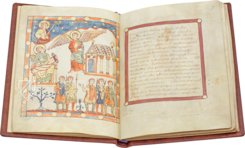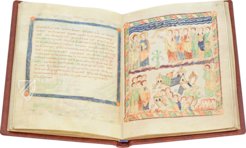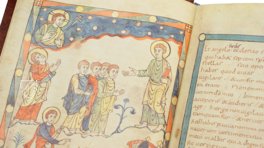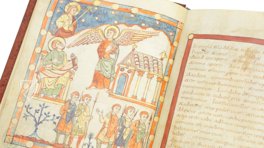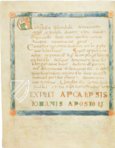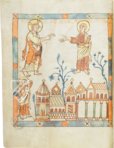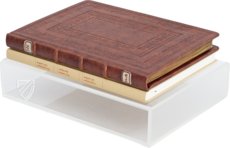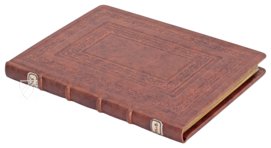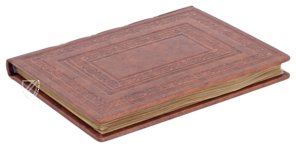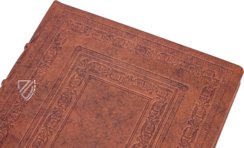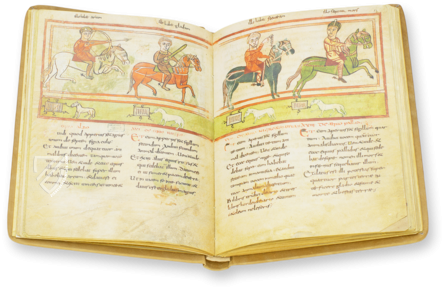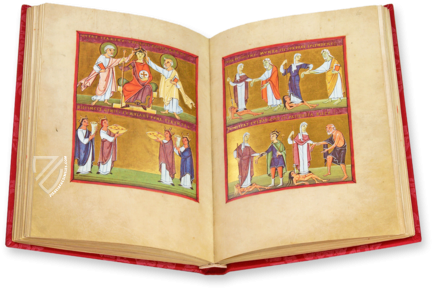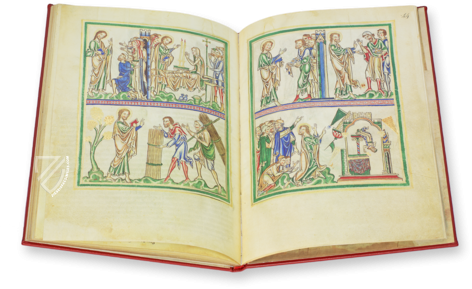Cambrai Apocalypse
(3,000€ - 7,000€)
The Cambrai Apocalypse impresses the beholder with its 46 astoundingly-well-preserved full-pages miniatures. Probably originating from Cambrai in northern France at the end of the 9th century, it is one of only four Carolingian Apocalypse manuscripts to survive. It distinctly stands out from among the rest because of its own distinct coloration and visual language. The painter managed to lend liveliness to the pictures with temple and city architecture which also makes it possible to pinpoint the location of the events. The stylistic connection of late antiquity and Frankish influences is interesting. Temple architecture with both Corinthian columns and palmettes serve as stages.
Cambrai Apocalypse
The Cambrai Apocalypse is counted among the oldest Apocalypse manuscripts in the world and is a true masterpiece. With 46 astonishingly-well-preserved full-page miniatures, it transplants the beholder into the exciting period of the Carolingian Renaissance of more than 1,100 years ago.
A Rarity in Book Art
Only four Carolingian Apocalypse manuscripts survive worldwide. Probably originating from Cambrai in northern France at the end of the 9th century, this specimen stands out from the rest through its coloration and imagery. It is furnished with countless narrative devices, which can only be sought for in vain in the others. Temple and urban architecture contributes a certain liveliness to the pictures and pinpoints the locations of the events. Additionally, stylized depictions of plants emphasize their closeness to reality and the effort with which they were made. The intensity of the colors is noteworthy, which still appear forceful after 1,100 years and have forfeited nothing of their luminosity.
Late Antiquity as a Source of Inspiration
The stylistic connection of late antiquity and Frankish influences, as can be recognized in the depictions, is particularly interesting. Temple architecture with both Corinthian columns and palmettes serve as stages. The figures perform before these, mostly dressed in tunics, togas, and sandals. The two-dimensional people communicate with one another through various hand gestures and can be connected with one another by the beholder. The composition always remains clear and harmonious, largely thanks to the frequently stripped composition. Additionally, each miniature is surrounded by richly patterned moldings, of which no two are alike.
Visions of the Last Days
Apocalypse manuscripts contain texts that thematize both the visions as well as prophecies of the coming end of the world. Most of these are connected with the presentation of the Last Judgement, as is described in the Gospel of Mathew. The Revelation of John originated in the first century after Christ and comprises the last book of the New Testament. The visions described therein have captivated people since then and has motivated artists above all to transmit the symbolic language in creative imagery. The surprising thing about Apocalypse manuscripts is that each is absolutely unique and implement the text in their own way. It for this reason above all that this is a beloved and fascinating collection area.
Codicology
- Alternative Titles
- Apokalypse von Cambrai
L’Apocalypse de Cambrai
Apocalisse di Cambrai
Apocalipsis cum imaginibus depictis - Size / Format
- 96 pages / 31.0 × 23.0 cm
- Origin
- France
- Date
- End of 9th century
- Epochs
- Style
- Genre
- Language
- Script
- Carolingian minuscule
- Illustrations
- 46 captivating full-page miniatures in colorful frames; texts also framed and decorated with plain initials; a large demon on the flyleaf is a later addition from the 12th century
- Content
- Apocalypse of St. John
- Artist / School
- School of Tours
Cambrai Apocalypse
The Woman and the Dragon
The Woman of the Apocalypse is one of the most prominent figures of John’s Revelation and is widely considered to be either the Virgin Mary or God’s people as a whole. She is shown holding her hands up with the sun and moon at her feet and crowned with twelve stars as the seven-headed dragon who wants to devour her child approaches. This event provokes the War in Heaven, whereby the child is saved and the Archangel Michael smites the Dragon, casting it down from heaven.
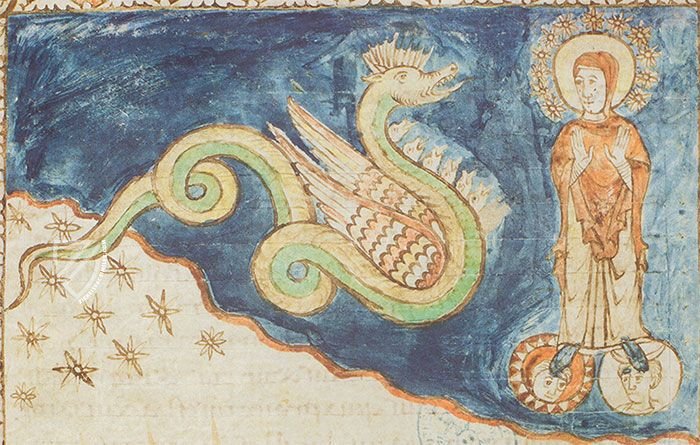
Cambrai Apocalypse
The Seventh Trumpet
“And the seventh angel sounded, and there were great voices in Heaven, saying, ‘The kingdoms of this world are become the kingdoms of our Lord and of His Christ, and He shall reign for ever and ever!’ And the four and twenty elders, who sat before God on their seats, fell upon their faces and worshiped God, saying, ‘We give Thee thanks, O Lord God Almighty, who art, and wast, and art to come, because Thou hast taken to Thee Thy great power, and hast reigned.” (Rev 11:15–19)
This is a Carolingian imitation of Late Antique art. The 24 elders assemble before a classical open temple with Corinthian capitals, palmettes, and tiled roof with the Ark of the Covenant. Below, John addresses the seven churches of Asia Minor next to a highly stylized plant. All figures are beardless and dressed in togas.
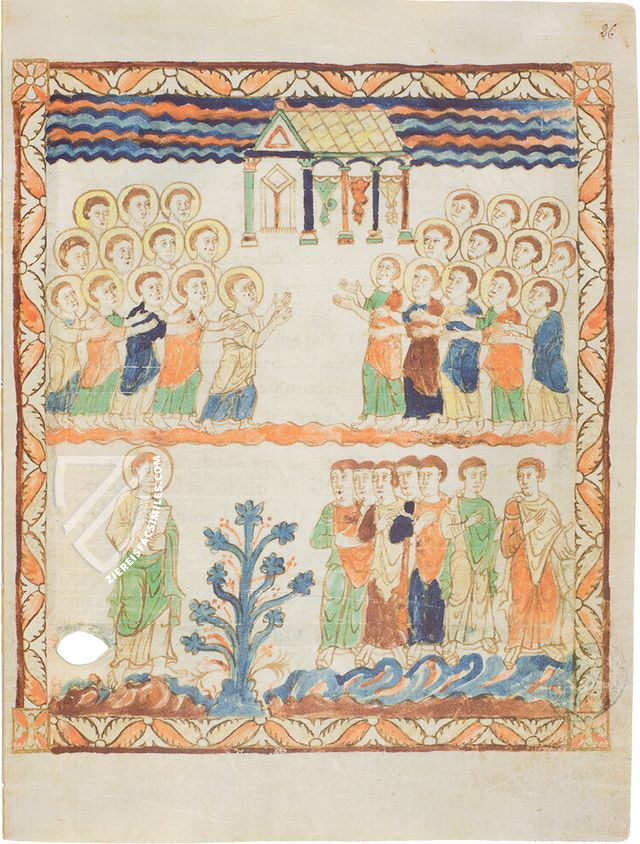
#1 Die Apokalypse von Cambrai
Languages: German, French, English
(3,000€ - 7,000€)
- Treatises / Secular Books
- Apocalypses / Beatus
- Astronomy / Astrology
- Bestiaries
- Bibles / Gospels
- Chronicles / History / Law
- Geography / Maps
- Saints' Lives
- Islam / Oriental
- Judaism / Hebrew
- Single Leaf Collections
- Leonardo da Vinci
- Literature / Poetry
- Liturgical Manuscripts
- Medicine / Botany / Alchemy
- Music
- Mythology / Prophecies
- Psalters
- Other Religious Books
- Games / Hunting
- Private Devotion Books
- Other Genres
- Afghanistan
- Armenia
- Austria
- Belgium
- Colombia
- Croatia
- Cyprus
- Czech Republic
- Denmark
- Egypt
- Ethiopia
- France
- Germany
- Greece
- Hungary
- India
- Iran
- Iraq
- Israel
- Italy
- Japan
- Lebanon
- Luxembourg
- Mexico
- Morocco
- Netherlands
- Palestine
- Peru
- Poland
- Portugal
- Russia
- Serbia
- Spain
- Sri Lanka
- Sweden
- Switzerland
- Syria
- Turkey
- Ukraine
- United Kingdom
- United States
- Uzbekistan
- Aboca Museum
- Ajuntament de Valencia
- Akademie Verlag
- Akademische Druck- u. Verlagsanstalt (ADEVA)
- Aldo Ausilio Editore - Bottega d’Erasmo
- Alecto Historical Editions
- Alkuin Verlag
- Almqvist & Wiksell
- Amilcare Pizzi
- Andreas & Andreas Verlagsbuchhandlung
- Archa 90
- Archiv Verlag
- Archivi Edizioni
- Arnold Verlag
- ARS
- Ars Magna
- ArtCodex
- AyN Ediciones
- Azimuth Editions
- Badenia Verlag
- Bärenreiter-Verlag
- Belser Verlag
- Belser Verlag / WK Wertkontor
- Benziger Verlag
- Bernardinum Wydawnictwo
- BiblioGemma
- Biblioteca Apostolica Vaticana (Vaticanstadt, Vaticanstadt)
- Bibliotheca Palatina Faksimile Verlag
- Bibliotheca Rara
- Boydell & Brewer
- Bramante Edizioni
- Bredius Genootschap
- Brepols Publishers
- British Library
- C. Weckesser
- Caixa Catalunya
- Canesi
- CAPSA, Ars Scriptoria
- Caratzas Brothers, Publishers
- Carus Verlag
- Casamassima Libri
- Chavane Verlag
- Christian Brandstätter Verlag
- Circulo Cientifico
- Club Bibliófilo Versol
- Club du Livre
- CM Editores
- Collegium Graphicum
- Collezione Apocrifa Da Vinci
- Comissão Nacional para as Comemorações dos Descobrimentos Portugueses
- Coron Verlag
- Corvina
- CTHS
- D. S. Brewer
- Damon
- De Agostini/UTET
- De Nederlandsche Boekhandel
- De Schutter
- Deuschle & Stemmle
- Deutscher Verlag für Kunstwissenschaft
- DIAMM
- Droz
- E. Schreiber Graphische Kunstanstalten
- Ediciones Boreal
- Ediciones Grial
- Ediclube
- Edições Inapa
- Edilan
- Editalia
- Edition Deuschle
- Edition Georg Popp
- Edition Leipzig
- Edition Libri Illustri
- Editiones Reales Sitios S. L.
- Éditions de l'Oiseau Lyre
- Editions Medicina Rara
- Editorial Casariego
- Editorial Mintzoa
- Editrice Antenore
- Editrice Velar
- Edizioni Edison
- Egeria, S.L.
- Eikon Editores
- Electa
- Emery Walker Limited
- Enciclopèdia Catalana
- Eos-Verlag
- Ephesus Publishing
- Ernst Battenberg
- Eugrammia Press
- Extraordinary Editions
- Fackelverlag
- Facsimila Art & Edition
- Facsimile Editions Ltd.
- Facsimilia Art & Edition Ebert KG
- Faksimile Verlag
- Feuermann Verlag
- Folger Shakespeare Library
- Franco Cosimo Panini Editore
- Friedrich Wittig Verlag
- Fundación Hullera Vasco-Leonesa
- G. Braziller
- Gabriele Mazzotta Editore
- Gebr. Mann Verlag
- Gesellschaft für graphische Industrie
- Getty Research Institute
- Giovanni Domenico de Rossi
- Giunti Editore
- Graffiti
- Grafica European Center of Fine Arts
- Guido Pressler
- Guillermo Blazquez
- Gustav Kiepenheuer
- H. N. Abrams
- Harrassowitz
- Helikon
- Hendrickson Publishers
- Henning Oppermann
- Herder Verlag
- Hes & De Graaf Publishers
- Hoepli
- Holbein-Verlag
- Hortus Deliciarum
- Houghton Library
- Hugo Schmidt Verlag
- Idion Verlag
- Il Bulino, edizioni d'arte
- ILte
- Imago
- Insel Verlag
- Instituto Nacional de Antropología e Historia
- Istituto dell'Enciclopedia Italiana - Treccani
- Istituto Ellenico di Studi Bizantini e Postbizantini
- Istituto Geografico De Agostini
- Istituto Poligrafico e Zecca dello Stato
- Italarte Art Establishments
- J. Thorbecke
- Jan Thorbecke Verlag
- Johnson Reprint Corporation
- Josef Stocker
- Josef Stocker-Schmid
- Jugoslavija
- Karl W. Hiersemann
- Kasper Straube
- Kaydeda Ediciones
- Kindler Verlag / Coron Verlag
- Kodansha International Ltd.
- Konrad Kölbl Verlag
- Kurt Wolff Verlag
- La Liberia dello Stato
- La Linea Editrice
- La Meta Editore
- Lambert Schneider
- Landeskreditbank Baden-Württemberg
- Leo S. Olschki
- Les Incunables
- Library of Congress
- Libreria Musicale Italiana
- Lichtdruck
- Lito Immagine Editore
- Lumen Artis
- Lund Humphries
- M. Moleiro Editor
- Maison des Sciences de l'homme et de la société de Poitiers
- Manuscriptum
- Martinus Nijhoff
- Maruzen-Yushodo Co. Ltd.
- MASA
- McGraw-Hill
- Militos
- Millennium Liber
- Müller & Schindler
- Nahar and Steimatzky
- National Library of Wales
- Neri Pozza
- Nova Charta
- Oceanum Verlag
- Odeon
- Orbis Mediaevalis
- Orbis Pictus
- Österreichische Staatsdruckerei
- Oxford University Press
- Pageant Books
- Parzellers Buchverlag
- Patrimonio Ediciones
- Pattloch Verlag
- PIAF
- Pieper Verlag
- Plon-Nourrit et cie
- Prestel Verlag
- Princeton University Press
- Prisma Verlag
- Priuli & Verlucca, editori
- Pro Sport Verlag
- Propyläen Verlag
- Pytheas Books
- Quaternio Verlag Luzern
- Reales Sitios
- Recht-Verlag
- Reichert Verlag
- Reichsdruckerei
- Riehn & Reusch
- Roberto Vattori Editore
- Rosenkilde and Bagger
- Roxburghe Club
- Salerno Editrice
- Sarajevo Svjetlost
- Schöck ArtPrint Kft.
- Scolar Press
- Scrinium
- Scripta Maneant
- Scriptorium
- Siloé, arte y bibliofilia
- SISMEL - Edizioni del Galluzzo
- Sociedad Mexicana de Antropología
- Société des Bibliophiles & Iconophiles de Belgique
- Soncin Publishing
- Sorli Ediciones
- Stainer and Bell
- Studer
- Styria Verlag
- Sumptibus Pragopress
- Szegedi Tudomànyegyetem
- Taberna Libraria
- Tarshish Books
- Taschen
- Tempus Libri
- Testimonio Compañía Editorial
- Thames and Hudson
- The Clear Vue Publishing Partnership Limited
- The Facsimile Codex
- The Folio Society
- The Marquess of Normanby
- The Richard III and Yorkist History Trust
- Tip.Le.Co
- TouchArt
- TREC Publishing House
- TRI Publishing Co.
- Trident Editore
- Typis Regiae Officinae Polygraphicae
- Union Verlag Berlin
- Universidad de Granada
- University of California Press
- University of Chicago Press
- Urs Graf
- Vallecchi
- Van Wijnen
- VCH, Acta Humaniora
- VDI Verlag
- VEB Deutscher Verlag für Musik
- Verlag Anton Pustet / Andreas Verlag
- Verlag Bibliophile Drucke Josef Stocker
- Verlag der Münchner Drucke
- Verlag für Regionalgeschichte
- Verlag Styria
- Vicent Garcia Editores
- W. Turnowsky
- Waanders Printers
- Wiener Mechitharisten-Congregation (Wien, Österreich)
- Wissenschaftliche Buchgesellschaft
- Wydawnictwo Dolnoslaskie
- Xuntanza Editorial
- Zakład Narodowy
- Zollikofer AG

